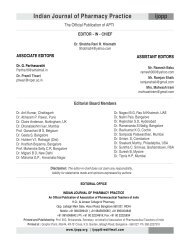Oct-Dec, 2011 - Indian Journal of Pharmacy Practice
Oct-Dec, 2011 - Indian Journal of Pharmacy Practice
Oct-Dec, 2011 - Indian Journal of Pharmacy Practice
- No tags were found...
You also want an ePaper? Increase the reach of your titles
YUMPU automatically turns print PDFs into web optimized ePapers that Google loves.
<strong>Indian</strong> <strong>Journal</strong> <strong>of</strong> <strong>Pharmacy</strong> <strong>Practice</strong>Association <strong>of</strong> Pharmaceutical Teachers <strong>of</strong> IndiaScenario <strong>of</strong> Pharmacovigilance and ADR Reporting among Pharmacists in DelhiAmrita P*, Roomi M.TDelhi Institute <strong>of</strong> Pharmaceutical Sciences and Research,Pushp Vihar sector III, M.B. Road, New Delhi, 110017A B S T R A C TSubmitted: 18/10/<strong>2011</strong>Accepted: 9/11/<strong>2011</strong>Adverse drug reactions enhance suffering <strong>of</strong> patients and increase morbidity and mortality. The aim <strong>of</strong> our study was to evaluate the awareness<strong>of</strong> pharmacists working in Delhi regarding pharmacovigilance, adverse drug reaction (ADR) and it's reporting. A questionnaire containing 27questions was prepared and distributed to 230 pharmacists. Response rate <strong>of</strong> this survey was 64.35%. Out <strong>of</strong> these, 31.76% were hospitalpharmacists, 26.35% were community pharmacists and 41.89% were medical representatives. Only 40.54% <strong>of</strong> pharmacists were found toknow the broad meaning <strong>of</strong> pharmacovigilance. The correct meaning <strong>of</strong> the term 'adverse drug reaction' was known to 27.70% pharmacists.Majority <strong>of</strong> pharmacists (77.03%) did not report the ADRs noticed by them. Only 4.05% pharmacists had tentative information that reporting canbe done at national monitoring center and/or regional monitoring centers. Further, only 3.38% pharmacists knew All India Institute <strong>of</strong> MedicalSciences/Lady Hardinge Medical College as the ADR monitoring centers <strong>of</strong> Delhi. Out <strong>of</strong> these, only 0.68% Pharmacists had the phone numberand/or address <strong>of</strong> these centers. It indicates that the ADR reporting is done by pharmacists at places other than <strong>of</strong>ficial monitoring centers.Pharmacists reported ADRs to physicians, manufacturing industry, product management team and chief pharmacist. Pharmacists in Delhi havepoor basic knowledge <strong>of</strong> pharmacovigilance, ADR and its reporting. Pharmacist's participation in ADR reporting is negligibly low. Education andtraining <strong>of</strong> pharmacists is essential to improve the ADR reporting. Pharmacist's active participation along with other healthcare providers wouldincrease the ADR reporting rate. Pharmacovigilance should be included in the pharmacy curriculum.Keywords: Adverse drug reaction, ADR reporting, Pharmacovigilance, Pharmacist.INTRODUCTIONIn 1960, use <strong>of</strong> Thalidomide for prevention <strong>of</strong> morningsickness by pregnant women gave excellent results but thedisaster struck when phocomelic babies were born. Thisforced the healthcare pr<strong>of</strong>essionals to become aware aboutthe adverse drug reactions, its implications on patient safetyand cost <strong>of</strong> treatment. Adverse drug reaction is a response to amedicine which is noxious and unintended and which occursat a dose used in humans for prophylaxis, diagnosis, therapy1or modification <strong>of</strong> physiological functions. ADRs add to thesuffering <strong>of</strong> patients and increase morbidity and mortalitybesides being a financial burden on society. It has beenestimated that ADRs cause up to 7% <strong>of</strong> all hospitaladmissions in the UK and 13% <strong>of</strong> all admissions to internal2medicine clinics in Sweden. In New Zealand, 12.9% <strong>of</strong> all3hospital admissions are due to adverse drug events. Fataladverse drug reactions rank among the most common causes4<strong>of</strong> death in the United States. ADRs have been estimated toAddress for Correspondence:Amrita Parle, Delhi Institute <strong>of</strong> Pharmaceutical Sciences and Research,PushpVihar sector III, M.B. Road, New Delhi, 110017E-mail: amrita.parle@gmail.com,account for up to 1,06,000 deaths annually in the United4,5States. The study <strong>of</strong> Bord et al indicated that, in patients whoexperience ADRs, death rates were 19.18% higher and the6length <strong>of</strong> hospital stay is 8.25% higher.India has become a destination for conducting clinical trials.During clinical trials, medicines are generally studied in acontrolled environment, for a relatively small number <strong>of</strong>patients, and usually for a limited duration. These trialssometimes exclude the elderly, the very young, and patientswith co-morbidities. Often patients on multiple drug therapyand patients with decreased renal and hepatic function areexcluded. For these patient populations, any vulnerability toADRs may be missed. Adverse reactions may occur at such alow frequency that they are not being detected in the smallnumbers <strong>of</strong> patients included in clinical trials. Furthermore, itis extremely difficult to predict how practitioners willactually use medications in practice. Once the drug iscommercially available, the exclusion criteria applied inclinical trials, no longer exist. Thus, exposure to the drug maylast longer, as therapy may continue long term, increasing thepossibility <strong>of</strong> previously undetected problems to arise and beidentified. Additionally, widespread use <strong>of</strong> medicines in thegeneral population can increase the chances for uncovering<strong>Indian</strong> <strong>Journal</strong> <strong>of</strong> <strong>Pharmacy</strong> <strong>Practice</strong> Volume 4 Issue 4 <strong>Oct</strong> - <strong>Dec</strong>, <strong>2011</strong> 29
















